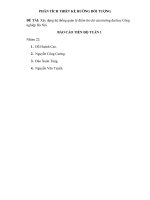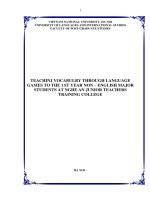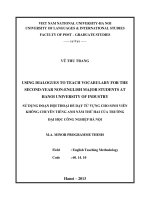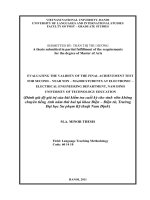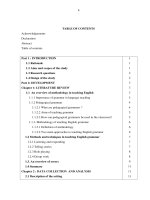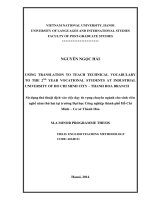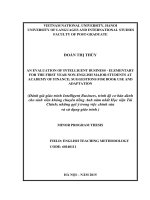Sử dụng đoạn hội thoại để dạy từ vựng cho sinh viên không chuyên tiếng Anh năm thứ hai của trường Đại học Cộng nghiệp Hà Nội
Bạn đang xem bản rút gọn của tài liệu. Xem và tải ngay bản đầy đủ của tài liệu tại đây (1.01 MB, 63 trang )
VIET NAM NATIONAL UNIVERSITY-HA NOI
UNIVERSITY OF LANGUAGES & INTERNATIONAL STUDIES
FACULTY OF POST – GRADUATE STUDIES
----- -----
VŨ THU TRANG
USING DIALOGUES TO TEACH VOCABULARY FOR THE
SECOND-YEAR NON-ENGLISH MAJOR STUDENTS AT
HANOI UNIVERSITY OF INDUSTRY
SỬ DỤNG ĐOẠN HỘI THOẠI ĐỂ DẠY TỪ VỰNG CHO SINH VIÊN
KHÔNG CHUYÊN TIẾNG ANH NĂM THỨ HAI CỦA TRƯỜNG
ĐẠI HỌC CÔNG NGHIỆP HÀ NỘI
M.A. MINOR PROGRAMME THESIS
Field
: English Teaching Methodology
Code
: 60. 14. 10
Hanoi – 2013
VIET NAM NATIONAL UNIVERSITY-HA NOI
UNIVERSITY OF LANGUAGES & INTERNATIONAL STUDIES
FACULTY OF POST – GRADUATE STUDIES
----- -----
VŨ THU TRANG
USING DIALOGUES TO TEACH VOCABULARY FOR THE
SECOND-YEAR NON-ENGLISH MAJOR STUDENTS AT
HANOI UNIVERSITY OF INDUSTRY
SỬ DỤNG ĐOẠN HỘI THOẠI ĐỂ DẠY TỪ VỰNG CHO SINH VIÊN
KHÔNG CHUYÊN TIẾNG ANH NĂM THỨ HAI CỦA TRƯỜNG
ĐẠI HỌC CÔNG NGHIỆP HÀ NỘI
M.A. MINOR PROGRAMME THESIS
Field
: English Teaching Methodology
Code
: 60. 14. 10
Supervisor : CẤN THỊ CHANG DUYÊN, MA
Hanoi – 2013
TABLE OF CONTENTS
Page
Declaration
i
Acknowledgements
ii
Abstract
iii
Table of contents
vi
PART A: INTRODUCTION
1
1. Rationale
2
2. Aims of the study
2
3. Research question
2
4. Research methodology
2
5. Scope of the study
3
6. Significance of the study
3
7. Design of the study
3
PART B: DEVELOPMENT
4
CHAPTER I: LITERATURE REVIEW
4
1. Teaching vocabulary in context
4
1.1. Definition of context
4
1.2. Context and vocabulary teaching & learning
5
1.3. Guessing and inferencing strategy
6
1.4. Contextual clues
8
1.5. Advantages and disadvantages of context in vocabulary teaching and 11
learning.
2. Dialogues as a context for teaching vocabulary
12
2.1. Dialogue definition
12
2.2. Types of dialogue
12
2.2.1. Grammar-demonstration dialogue
13
2.2.2. Conversation-facilitation dialogue
13
iv
2.3. Features of dialogue
14
2.3.1. Linguistic features
14
2.3.1.1. Phonetic features
14
2.3.1.2. Lexical features
14
2.3.1.3. Syntactic features
15
2.3.1.4. Objective features and situational features
15
2.3.1.5. Psychological features
16
2.3.2. Methodological features
16
2.4. Stages of teaching dialogues
16
2.4.1. Presentation Stage
17
2.4.2. Practice Stage
21
2.4.3. Production Stage
24
CHAPTER II: ENGLISH TEACHING AND LEARNING CONTEXT 26
AT HANOI UNIVERSITY OF INDUSTRY
2.1. Students and their background
26
2.2. Teachers and teaching methods
27
2.3. Material and facilities
27
2.4. Remarks on dialogues in the course book
28
CHAPTER III: METHODOLOGY
29
3.1. Rationale for the use of an action research
29
3.2. Action research procedure
30
3.3. Background of the study
32
3.3.1. Participants
32
3.3.2. Data collection instruments
33
3.3.2.1. Test
33
3.3.2.2. Group Interview
33
3.3.4. Data collection procedure
34
CHAPTER IV: DATA ANALYSIS
36
v
4.1. The result of the pre-test and post-test
36
4.2. The result of group interview
37
4.2.1. Students‟ opinions of the effect of using dialogues to learn vocabulary 37
4.2.2. Preference of activities and exercises related to dialogue
37
PART C: CONCLUSION
38
1. Major findings
38
2. Implication
39
3. Limitation and suggestions for the further studies
40
REFERENCES
42
APPENDIX 1
I
APPENDIX 2
V
APPENDIX 3
XI
APPENDIX 4
XII
APPENDIX 5
XIV
vi
PART A: INTRODUCTION
1. RATIONALE
Hammer (1991) states “If language structure makes up the skeleton of language,
then it is vocabulary that provides the vital organs and flesh”. It is clearly seen from
this statement that vocabulary is central to language and is of great significance in
language learning. In the past, the importance of vocabulary teaching and learning was
generally neglected for a long time, yet in recent years, the nature of vocabulary and its
role in learning and teaching has been an increasingly interesting topic of discussion for
researches, teachers, curriculum designers, theorists and
others involved in second
language learning. Accordingly, numerous research studies related to this topic have been
carried out. It comes to a conclusion based on the research findings that “Through
research the scholars are finding that lexical problems frequently interfere with
communication; communication breaks down when people do not use the right words ".
(Allen 1983). This highlights the significance of vocabulary in classroom teaching, for
without vocabulary it is hardly possible to communicate.
When teaching the second-year students at Hanoi University of Industry, the
writer finds out that vocabulary learning is a big problem to the students. For young
learners, perhaps it is less difficult to learn vocabulary items for the first time than to
consolidate and remember them. We often hear young learners complain that they
keep learning and forgetting. When English language young learners are acquiring new
vocabulary, they need concrete methods to collect, store, and retrieve words for retention
and future use. Therefore, it is necessary to find out effective methods to help young
learners retain new words in long-term memory. According to Oxford and Crookall
(1988), learning words in context is an effective vocabulary learning strategy and a main
approach to improve vocabulary knowledge. This has urged the researcher to carry out
this action research.
1
2. AIMS OF THE STUDY
The study is aimed at:
Examining the feasibility of using dialogues to teach vocabulary for the secondyear non-English major students in Hanoi University of Industry.
Measuring the effectiveness of this vocabulary teaching technique on students‟
vocabulary acquisition.
Hopefully, based on the results of the study, the research aims to offer English teachers
some suggestions for the better use of dialogues in their classes.
3. RESEARCH QUESTION
The research was to seek answers to the following question:
1. What is the students’ attitude toward learning vocabulary through dialogues?
2. “To what extent does using dialogues to teach vocabulary affect students’
vocabulary acquisition?”
4. RESEARCH METHODOLOGY
To obtain the aims mentioned above, an action research is chosen for the study. In
this action research, pre-test and post-test are designed and used as data collection
instruments. The pre-test was exploited to gain the overview about student‟s vocabulary
level before the study. The post-test was administered to the students after four weeks in
which dialogues were applied to help students learn vocabulary to measure the impact or
effectiveness of this technique on students‟ vocabulary acquisition. Collected scores were
then processed and analyzed by T-test Paired Sample. In addition, a group interview was
conducts to get more in-depth data.
2
5. SCOPE OF THE STUDY
It is impossible to cover every aspect of language theory and practice in this study.
Therefore, the study focuses on using dialogues to teach vocabulary for the second-year
non-English major students in Hanoi University of Industry.
6. SIGNIFICANCE OF THE STUDY
The results of this action research will help the author to improve her approaches
to vocabulary teaching. Those results can also be helpful to other teachers in the
university or in other universities which have the same problems (vocabulary teaching &
learning) with the university where this research was conducted.
7. DESIGN OF THE STUDY
The research includes three main parts: Part A, Part B and Part C.
Part A: Introduction presents the rationale, the aims of the study, the research
question, the method of the study, the scope of the study, the significance of the study
and the design of the study.
Part B: Development consists of four chapters:
Chapter 1: literature review
Chapter 2: English teaching and learning context at Hanoi University of Industry
Chapter 3: methodology
Chapter 4: data analysis and discussion
Part C: Conclusion provides summary of major findings, implication, as well as
presents limitation and suggestion for further study.
3
PART B: DEVELOPMENT
CHAPTER I: LITERATURE REVIEW
1. Teaching vocabulary in context
1.1. Definition of context
Context is an important concept. Therefore, there have been many different
definitions about context.
The word “context” comes from Latin words “co”, which means “together” and
“text”, which means words, sentences. Thus we can define that “context is the
circumstance in which the word is used”. In other words, it is the relationship between a
word and other words around it.
In the light of linguistics, David Nunan (1993:7) points out in his book that “context
refers to the situation giving rise to the discourse and within which the discourse is
embedded”.
Another as noted by Nguyen Hoa (2000: 39), “context seems to be the minimal
stretch of language that helps to understand what is written and spoken”.
In the light of human communication, Hymes (1974) views contexts as a limiter of
the range of possible interpretations, and, on the other hand, a supporter of the intended
interpretation. Context can be seen as information and in turn, information is that which
reduces uncertainly.
In this study, context is defined as a particular linguistic environment where
a particular word is used and interpreted semantically and pragmatically. In other words,
in linguistics, context carries tremendous importance in disambiguation of meanings as
well as in understanding the actual meaning of words. Consequently, if learners cannot
contextualize new words, the words are of little value and if meaning is not
contextualized, it will be not easy for learners to memorize in addition to use new words
4
appropriately. As a result, using context to teach vocabulary is considered as one of
effective vocabulary teaching technique.
1.2. Context and vocabulary teaching & learning
Learning vocabulary is an important factor in fluent second language (L2) speech.
Researchers have tried to find effective ways of teaching L2 vocabulary to L2 learners.
Different methods like glosses, mnemonic devices, and morphological and syntactic
analyses are some examples of the attempts of second language teaching researchers
to find practical ways of teaching L2 vocabulary (Min, 2008). From among all the
proposed methods, contextualization has received special attention. Webb (2007) points
to the fact that different aspects of a word like its semantic relationships, syntagmatic and
paradigmatic associations, and even its collocational behavior can be learned through
context.
It is believed that context can have a positive effect on vocabulary acquisition of
L2 learners. Researchers like Engelbert and Theuerkauf (1999) refer to the positive effect
of context on vocabulary learning reported in the literature. Corrigan (2007) too claims
that seeing vocabulary items in the context provides learners with information
about the characteristic features of that word and the linguistic context in which that
specific word occurs. Gardner (2007) argues that many words in English have multiple
meanings which are context-dependent. When one tries to teach those words isolated
from context, they lose their meanings and become vague.
In the work namely “The book of Learning and Forgetting”, Frank Smith asserts
“Teaching one word at a time out of context is the worst way of teaching vocabulary,
with rapid forgetting almost guaranteed.” In his opinion, people assimilate new words
from context the first time they read them, “provided that gist of the material being read
is both interesting and comprehensible. Within five more encounters, the word and its
conventional meaning are usually firmly established in the mind of the reader.”
5
One principle of effective vocabulary learning is to provide multiple exposures to
a word‟s meaning. This is gre at improvement in vocabulary when students encounter
vocabulary words often (National Reading Panel. 2000). As stated by Stahl(2005),
students probably have to see a word more than once to put it firmly in their long-term
memories. In other words, it is essential that vocabulary instruction provide students with
opportunities to encounter words repeatedly and in more than one context. Teaching
vocabulary in context is probably the most useful technique, because it gets students to
work out the meaning of words for themselves.
Kruse (1979) made some suggestions for teaching vocabulary in context:
1. Word elements such as prefixes, suffixes and roots: recognizing component
parts of words, words families is of great value because it is one of the most
significant vocabulary skills the students may need. It also decreases the
number of new words they will encounter and increases their control of the
English lexicon.
2. Pictures, diagrams, charts: students may relate the illustration with the item
that is difficult to understand.
3. Clues of definition: students must be taught to notice many types of useful
definition clues like parenthesis or footnotes, synonyms and antonyms.
4. Inference clues from discourse: students can benefit from example clues,
summary clues and experience clues to infer the meaning from the context.
5. General aids: this includes the function of the word such as noun, adjective,
etc.
1.3. Guessing or inferencing strategy
“Guessing from contexts is the most important vocabulary learning technique and
time spent practicing it is well justified. It provides access to thousands of words”
(Nation, 1990:130)
6
Guessing unknown words from context is an important vocabulary strategy which
is studied and encouraged most widely so language learners must know how to guess
unknown words successfully. Guessing meaning of unknown words from context mostly
refers to inferring the meaning of a word from surrounding words in a written text. In this
study, these terms are used interchangeably.
As said by McCarthy (1990:125), “inferring involves creating a schema for the
unknown word(s), based on world knowledge and previous experience, both of the world
and texts. In other words, inferring means drawing conclusion as to word meaning by
following certain rational steps in the face of the evidence available.”
For example, consider the word “give” in different contexts (Anderson & Nagy,
1991):
John gave Mary a kiss.
John gave Frank five dollars.
The doctor gave the children an injection.
The orchestra gave a stunning performance.
All of these involve some kind of transmitting with a giver and a recipient and
something tangible or intangible. But the act giving is radically different in these cases.
Each meaning of the verb “give” can be grasped through guessing strategy.
It is vital to understand when teaching learners to make contextual guesswork that
they will not be able to guess successfully until they know about 95-98% of the other
words in the text. Therefore, it is wise not to start teaching this strategy too early in the
learning process, because the learners will not know enough other words to guess
successfully. Teacher can help students to discover unknown-word meaning with specific
techniques and practice in contextual guesswork. Teacher can make use of the following
general strategies for guessing meaning from context:
7
1. Attempt to infer the meaning of the unknown word from the general
context preceding the word
2. Attempt to infer the meaning of the unfamiliar word from the general
context that follows the word
3. Attempt to infer the meaning of the unknown word by looking at the word
parts
4. Attempt to define the word
5. Attempt to infer the meaning of the unknown word by looking for specific
cues in the surrounding context
6. Attempt to construct a coherent definition, using internal and external cues,
as well as the general ideas expressed by the passage and general world
knowledge
7. Check definition to see if meaning is appropriate for each appearance of the
word in the context
(Sternberg et al., 1983:140)
1.4. Contextual clues
The use of context clues plays a vital role in language acquisition. Actually most
of students‟ vocabulary acquisition may be attributable to using context clues. Context
clues are “the clearly stated or implied words or phrases which help to comprehend
unfamiliar words in context because they can activate the corresponding context to
clarify the contextual meanings of the words concerned” (Sun & Zhou, 2005, p.49).
Context clues are divided into quite a few types depending on various
criteria and individuals. In this study, the author will introduce six major types of
contextual clues. It includes the following types:
Definition/Explanation Clues
Restatement/Synonym Clues
8
Contrast/Antonym Clues
Examples/ Illustrations Clues
Inference/General Context Clues
Punctuation
The first type is definition or explanation clues. The author uses definition to
suggest the word meaning in the text. The meaning follows the word immediately or
signal words such as “is, means, called, and refers to, because” or appears between
commas, parentheses, or dashes. For instance: Marsha is insatiable; she can eat all day
and never feel full. Here, the second part of the sentence (“she can eat all day and never
feel full”) is used to explain the first part of the sentence (“Marsha is insatiable”). We
can conclude, then, that “insatiable” means “incapable of being full” or “incapable of
being satisfied.”
For the second type, a word's or phrase's meaning is explained immediately
following its use with the use of a synonym or restated in easier language. For example:
"Lou was sent to the haberdashery to find a new suit. He needed to wear one for his
uncle‟s wedding.” Because the sentence says that Lou would find a suit at the
haberdashery, then it must be a place where clothes for men are sold.
Contrast or Antonym Clues is the third type. Sometimes an unfamiliar word may
be used in contrast to a familiar word or group of words. You can infer the meaning of
the unfamiliar word by giving it the opposite meaning of the familiar word. In this type,
you can find signal words for contrasts: but, on the other hand, in contrast to, however,
although, unlike. For example: Unlike Robin, who is full of life, Rachel is lackluster .The
opposite of “full of life” is “empty of life.” The word “lackluster” is used to contrast
Robin and Rachel. We can conclude, then, that the word “lackluster” means “lacking
liveliness.”
In the fourth type, the author tries to using examples or illustrations show what a
word means. The author may give one example or many. “Such as,” “including,”
9
“consists of,” “for example,” or colons, commas, semicolons, and dashes can also signal
clues for this type. For instance: In college, you can choose courses from a broad range of
academic disciplines, such as history, economics, mathematics, and psychology. Besides
the primary meaning of the word “discipline”, in this sentence this word also has a
secondary meaning. The word is followed by several examples: history, economics,
mathematics, and psychology. We can conclude, then, that each of these subjects is an
example of a discipline and that the word “discipline” means “a branch of instruction or
learning.”
Sometimes a word or phrase is not immediately clarified within the same sentence.
Relationships, which are not directly apparent, are inferred or implied. The reader must
look for clues within, before, and after the sentence in which the word is used. It is
Inference or General Context Clues. For example: While exploring the ancient pyramids
in Egypt, the scientist discovered the mummy of a king buried in a sarcophagus with
elaborate designs. Look at the details: Sarcophagus is a noun because the noun
determiner “a” comes before it. It‟s probably a thing since a king was buried in it and
because it has elaborate designs on it. Now, it was found in the ancient pyramids in Egypt
with a mummy in it. That means it‟s old. We can make a inference that a sarcophagus
must be a coffin used in ancient times for burying the dead.
The last type is punctuation. Readers can also use clues of punctuation and type
style to infer meaning, such as quotation marks (showing the word has a special
meaning), dashes, parentheses or brackets (enclosing a definition), and italics (showing
the word will be defined). For example:
Brackets: A tornado (a violent storm of twisting wind) struck Edmonton
and caused a lot of damage.
Commas: A tornado, a violent storm of twisting wind, struck Edmonton
and caused a lot of damage.
10
Dashes: A tornado – a violent storm of twisting wind – struck Edmonton
and caused a lot of damage.
1.5. Advantages and disadvantages of context in vocabulary teaching and learning
Teaching and learning vocabulary in context is the most important of all sources.
The real value of context lies in its authenticity, the benefits of which are of three
different sorts. As it is suggested by Monsell (1985), first of all, assessing the meaning of
a word in context obliges students to develop strategies like anticipating and inferring,
which become highly beneficial as learning progresses because they instill an attitude of
self-reliance that is the distinctive feature of proficiency. Secondly, systematically
meeting new vocabulary items in context emphasizes the fact that the words are actually
used in discourse for purposes of communication. Lastly, all the factors mentioned above
can be said to contribute to a learner‟s L2 autonomy and to facilitate the transfer of
knowledge that accompanies it. Moreover, they underline the fact that the mental
presentation of a word‟s meaning improves together with successive encounters in
different contexts. Thus, it may be subjected to modification because new and finer
semantic distinctions are added.
However, this strategy also has following disadvantages. In the first place, the
strategy is complex and often difficult to carry out successfully, because, the learners
need to know about 95% of the words in the text, (Liu, & Nation, 1985, Nation,
1990, cited in Hunt & Beglar, 1998). This puts lower proficiency students with less
vocabulary at a distinct disadvantage. Next, since a word may have several meanings, the
use of context clues will prove effective only when a general meaning of a word is
adequate. When the surrounding words are not familiar, when the definite meaning is
required, or when the word in question is a key word, using context clues might not be a
good idea. Finally, incorrect inferences lead to a real misinterpretation, which has a bad
influence on students‟ vocabulary acquisition. If students remember wrong meaning at
11
scratch, they will have a serious problem using it later and they need more time to refresh
their mind & digest new word meaning.
As a result, for the teacher who teaches vocabulary using this approach, it is
important to consider the difficulty level of the text , the students‟ vocabulary level as
well as the students‟ own background knowledge.
2. Dialogues as a context for teaching vocabulary
2.1. Dialogue Definition
The term, dialogue is derived from the Greek, dialogos, in which dia means
through and logos means words.
William Isaacs, in his book, Dialogue, calls dialogue a "flow of meaning." This
flow of meaning occurs in the context of a relationship among the people gathered to talk.
In common sense, „Dialogue‟ is defined as a process of conversation between two
or more persons for exchanging opinions or ideas.
As stated by Alexander Baid, “A dialogue is basically a stimulus/respond situation
involving the reception and the production of the spoken form of the language.” This
definition focuses on the processes in a dialogue.
Ron Forseth sees dialogue from the methodological point of view as a written
conversation between two or more people or it can be a transcription of a real
conversation by a teacher in order to teach a language point (1997:105).
2.2. Types of dialogue
According to Rivers (1981), there are two broad categories of dialogues: grammardemonstration dialogues and conversation-facilitation dialogue.
12
2.2.1. Grammar-demonstration dialogue
This is the kind of dialogue which is designed to demonstrate grammatical rules,
and examples of rules in use. They provide contextualized examples from which students
will deduce generalizations about a particular grammatical structure.
For example: this dialogue focused on presenting the Near Future Tense in English.
Bill: Where are you going this evening?
Jane: I am going out with my family. We are going to the cinema.
Bill: What are you going to see?
Jane: “Gone with the wind”. My cousin‟s going with us. He and his wife are going
to meet us there
2.2.2. Conversation-facilitation dialogue
This type of dialogue provides learners with useful expressions and constructions
for daily conversation. That helps much in creating communicative skills for learners. For
example: many useful expressions in telephoning presented in the following dialogue
(New Headway Pre-intermediate, Unit 10, page 85)
13
2.3. Features of dialogue
A dialogue is a spoken form of language therefore it has all the features of spoken
language.
2.3.1. Linguistic features
2.3.1.1. Phonetic features
In general, this feature includes stress and intonation. In English, two factors are
very important because they express the feeling, emotion and attitude of speakers.
Different places of stress or different intonation may cause different meaning of the same
expressions.
For example:
A: Have you seen Ann?
B: Yes. (Falling intonation indicates „I have answered your question and do not
intend to add anything else‟)
Or:
A: E.g. Have you seen Ann lately?
B: Yes… (Rising intonation indicates „I want to continue the conversation, I am
curious‟)
2.3.1.2. Lexical features
In dialogue, it is common that we use a great deal of contraction instead of long
form. For example, “isn‟t”, “don‟t” “can‟t” and so on. Furthermore, in some informal
situation, utterances are shortened by the ellipsis of some parts in utterances but the
listeners still understand the message of the dialogue. What‟s more, there are many
14
hesitating markers such as “oh”, “uhm”… in the spoken language, especially in
dialogues. These elements make the dialogue more natural.
For example:
A: Where‟s my book?
Or
A: Coffee?
B: On the sofa.
B: No, thanks.
2.3.1.3. Syntactic features
Unlike the written language, the spoken one is not highly structured and organised
and sometimes ungrammatical because of some features mentioned above. However, it
doesn‟t make any difference for both speakers and learners because what they focus is
whether the message is understandable or not.
2.3.1.4. Objective features and situational features
In order to choose an appropriate style of language, before joining a conversation,
people should take in consideration the following factors such as: whom they
communicate with, in what situation the conversation takes place as well as the aims of
conversation. For example:
A dialogue between two people who
Or: A dialogue between two
meet for the first time.
friends
A: Excuse me! Could you tell me the time, A: Hey, Mary, tell me the time.
please?
B: 2p.m
B: It is 2p.m.
A: Ok
A: Thank you very much.
B: You‟re welcome.
15
2.3.1.5. Psychological features
There are many factors which affect the success of a dialogue such as age,
occupation, culture, speakers‟ and learners‟ background knowledge and especially
psychological factor. Psychological features refer to the interest of the participant to
his/her partner and to the topic of the conversation. This factor has a great influence in
the success of speaking activity.
2.3.2. Methodological features
A lot of educators and researchers state that using context in general and dialogue
in particular to teach vocabulary is considered as one of effective vocabulary teaching
technique. In dialogue, words, phrases, useful expressions are presented in a meaningful
context, which helps students much in learning how to use them correctly and creates a
firm link between language and situation. Moreover, teaching and learning through
dialogue not only helps teachers to attract students‟ attention easier but also gives
students lots of opportunities for practice and speaking which are more preferable than
doing grammatical exercises or reading and writing tasks.
2.4. Stages of teaching dialogues
2.4.1. Presentation Stage
Purposes
The presentation stage aims to give students the opportunities to explore the model
dialogue. So as to reach this aim, students should understand new words, expression,
grammatical items as well as pronunciation, stress and intonation.
Teacher‟s role
In this stage, the teacher works as a guide and an informant. With the first role, the
teacher guides students to access to the dialogue by setting the scene for the dialogue,
eliciting from the students‟ knowledge, experience of the language used in the scene.
16
Thanks to such help, students can discover the dialogue themselves. With the second role,
the teacher is the person who introduces new knowledge to students such as new words,
new expressions, new grammatical structures or pronunciation.
At this stage, there are some principles the teacher should keep in their mind as
follow:
Meaning, i.e. relate the word to an appropriate object or context
Usage, i.e. knowledge of its collocations, metaphors and idioms, as well as style
and register (the appropriate level of formality),to be aware of any connotations
and associations the word might have
Word formation, i.e. ability to spell and pronounce the word correctly, to know
any derivations (acceptable prefixes and suffixes),
Grammar, i.e. to use it in the appropriate grammatical form
(Harmer, 1993)
Techniques
The following techniques for presentation stage are widely used for dialogue teaching.
They consist of visual techniques and verbal ones.
1. Visual techniques
Real object
When the teacher uses real objects to present new words especially concrete
nouns, students are directed towards the image of the word and memorize them more
quickly.
For example: to present the word “a watch” (New Headway Pre-intermediate, Unit
1, page 12), the teacher can pick up a watch, point at it and say “This is a watch.” Of
course, students know at once what a watch is.
17
Pictures and drawing
Pictures here include flashcards, photographs, blackboard drawings, wall charts,
pictures from the textbook, magazine and newspaper.
For instance: to show the meaning of the word “plane”, the teacher tells students
to open the book New Headway Pre-intermediate at page 33 and look at the picture
and then ask them “what is this?”. Thanks to the picture, students can easily
answer the question.
Besides, the teacher can use simple blackboard drawings to convey word meaning
like this:
To run
To stand
To sum up, if pictures and drawings are well exploited, they will convey the
meaning of words vividly and clearly an as well as attract students‟ attention.
18
Body language (Gestures, mime, actions, facial expressions).
They are supplements to convey word meaning. This way is enjoyable and
colourful so the new words will be kept in students‟ long-term memory. This technique is
especially effective for teaching verbs and adjectives showing moods.
For example: to teach the phrases “sit down” and “stand up” (unit 11, page 92), the
teacher can do these actions in front of the class. The meaning of two phrases will be
introduced easily. Or some words expressing emotion like “sad” or “happy” can be taught
by facial expression.
However, when using these techniques, the teacher should notice that action, mine,
gestures performed by him/her must be clear and reasonable so as to avoid
misunderstanding of the meaning of words.
2. Verbal techniques
Contextual guesswork
Contextual guesswork can be used effectively while new vocabulary especially
abstract words are presented through dialogues because each dialogue is a context itself.
In order to guess the meaning of unfamiliar words, students had better see those words in
the relationship with words around; therefore this technique is considered rather difficult.
For example:
A: What‟s the weather like in December?
B: It‟s cold.
Proposed that “cold” is the word that students have to guess the meaning here. In
this case, the teacher firstly points out the key words of the dialogue: “weather” and
“December” and then asks students the meaning of these words. Surely, students can
easily deduce the meaning of “cold”.
19
Using definitions, examples, synonyms and antonyms
In some situations, definition may be the best choice for introducing new words.
For example: the word “nanny” ( New Headway Pre-intermediate, Unit 8, page 67) can
be conveyed to students by giving definition: a nanny is a person who looks after a child.
Besides that, the teacher should make full use of the synonyms to introduce the
meaning of the new word because “words are best taught in groups of similar meaning.”
(Lewis. M & Hill. J, 1985:101). Or another choice for teacher is that “a word can often be
easily defined if the students know its opposite” (Hay Craft, 1978:46). For example: to
introduce the meaning of the word “fast” (Unit 2, page 16), the teacher can use the known
word “slow” (Unit 2, page 12) as its antonym.
Last but not least, vocabulary can sometimes be classified into groups with a
superordinate such as animals (dog, cat...), furniture (desk, chair...) and so forth. With
such superordinate words, giving examples to illustrate their meaning is of great use.
Translation
It is common said that translation is the quickest and easiest way to present new
words. It is used to teach abstract words. Yet, translation is a double-weapon that needs
clarifying by further examples in different contexts.
For example:
He is a plumber. (New Headway Pre-intermediate, unit 8, page 67): Anh ấy là thợ
sửa ống nước.
I did the washing-up last night. It‟s your turn tonight. (New Headway Preintermediate, unit 9, page 73): Tôi rửa bát tối hôm qua rồi. Hôm nay đến lượt bạn.
20
